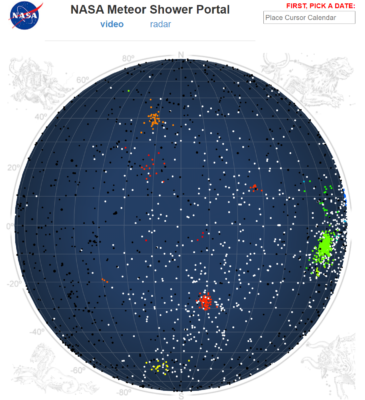Spotting a meteor flash across the sky is a rare event for most people, unless you’re the operators of the CAMS meteor shower surveillance project, who frequently spot more than a thousand in a single night and recently discovered two new showers.
CAMS, which stands for Cameras for Allsky Meteor Surveillance, was founded in 2010. Since 2017, it’s been improved by researchers using AI at the Frontier Development Lab, in partnership with NASA and the SETI Institute.
The project uses AI to identify whether a point of light moving in the night sky is a bird, plane, satellite or, in fact, a meteor. The CAMS network consists of cameras that take pictures of the sky, at a rate of 60 frames per second.
The AI pipeline also verifies the findings to confirm the direction from which meteoroids, small pieces of comets that cause meteors, approach the Earth. The project’s AI model training is optimized on NVIDIA TITAN GPUs housed at the SETI Institute.
Each night’s meteor sightings are then mapped onto the NASA meteor shower portal, a visualization tool available to the public. All meteor showers identified since 2010 are available on the portal.
CAMS detected two new meteor showers in mid-May, called the gamma Piscis Austrinids and the sigma Phoenicids. They were added to the International Astronomical Union’s meteor data center, which has recorded 1,041 unique meteor showers to date.
Analysis found both showers to be caused by meteoroids from long-period comets, which take more than 200 years to complete an orbit around the sun.
Improving the Meteor Classification Process
Peter Jenniskens, principal investigator for CAMS, has been classifying meteors since he founded the project in 2010. Before having access to NVIDIA’s GPUs, Jenniskens would look at the images these cameras collected and judge by eye if a light curve from a surveyed object fit the categorization for a meteor.
Now, the CAMS pipeline is entirely automated, from the transferring of data from an observatory to the SETI Institute’s server, to analyzing the findings and displaying them on the online portal on a nightly basis.
With the help of AI, researchers have been able to expand the project and focus on its real-world impact, said Siddha Ganju, a solutions architect at NVIDIA and member of FDL’s AI technical steering committee who worked on the CAMS project.
“The goal of studying space is to figure out the unknowns of the unknowns,” said Ganju. “We want to know what we aren’t yet able to know. Access to data, instruments and computational power is the holy trifecta available today to make discoveries that would’ve been impossible 50 years ago.”
Public excitement around the CAMS network has spurred it to expand the number of cameras fourfold since the project began incorporating AI in 2017. With stations all over the world, from Namibia to the Netherlands, the project now hunts for one-hour long meteor showers, which are only visible in a small part of the world at a given time.
Applying the Information Gathered
The AI model, upon identifying a meteor, calculates the direction it’s coming from. According to Jenniskens, meteors come in groups, called meteoroid streams, which are mostly caused by comets. A comet can approach from as far as Jupiter or Saturn, he said, and when it’s that far away, it’s impossible to see until it comes closer to Earth.
The project’s goal is to enable astronomers to look along the path of an approaching comet and provide enough time to figure out the potential impact it may have on Earth.
Mapping out all discoverable meteor showers brings us a step closer to figuring out what the entire solar system looks like, said Ganju, which is crucial to identifying the potential dangers of comets.
But this map, NASA’s meteor shower portal, isn’t just for professional use. The visualization tool was made available online with the goal of “democratizing science for citizens and fostering interest in the project,” according to Ganju. Anyone can use it to find out what meteor showers are visible each night.
Check out a timeline of notable CAMS discoveries.

